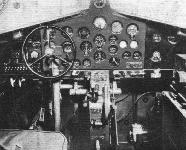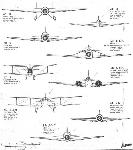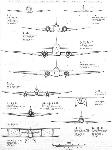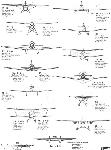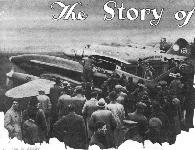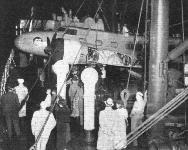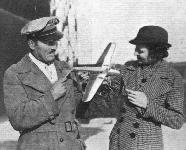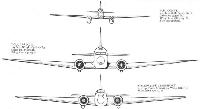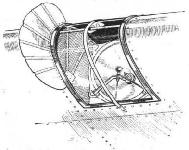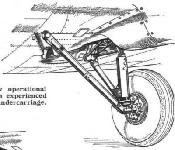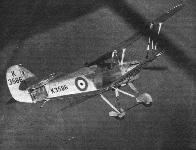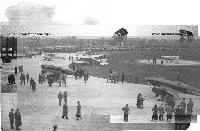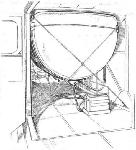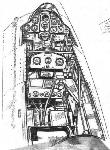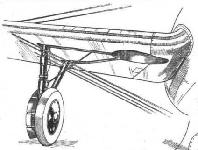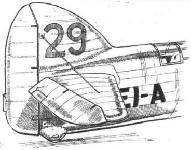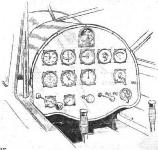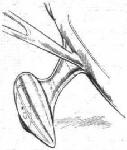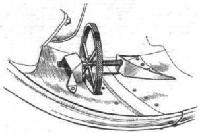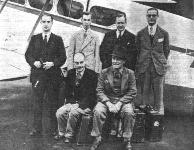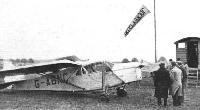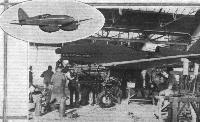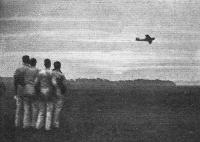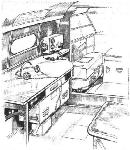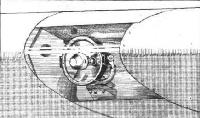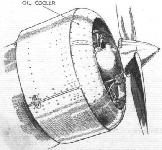Фотографии
-
A "MULTIPLACE DE COMBAT." The Potez 54 shown here is fitted with two Hispano-Suiza Ybrs engines giving a maximum of 860 h.p. each. A top speed of 198 m.p.h. is claimed
Самолёты на фотографии: Potez Potez 54 - Франция - 1933
-
A MODERN "CONTROL ROOM": The cockpit of the single-engined Vultee V-1A, which cruises at 215 m.p.h. The usual instruments for normal and blind flying can be seen, as well as the airscrew pitch adjustment, and the flap and undercarriage retraction controls.
Самолёты на фотографии: Vultee V-1A - США - 1933
-
Самолёты на фотографии: Airspeed Viceroy / AS.8 - Великобритания - 1934Beechcraft Model 17 Staggerwing - США - 1932Bleriot Bleriot-111 - Франция - 1929British Klemm BK-1 Eagle - Великобритания - 1934Caproni Bergamaschi PL-3 - Италия - 1934De Havilland Dragon Rapide / Dominie / D.H.89 - Великобритания - 1934Vance Flying Wing / Viking Cargo Plane - США - 1932Vultee V-1A - США - 1933
-
Самолёты на фотографии: Airspeed Courier / AS.5 - Великобритания - 1933Airspeed Envoy / AS.6 - Великобритания - 1934Boeing Model 247 - США - 1933Douglas DC-1 / DC-2 / C-32 / C-39 - США - 1933Fairey Fairey IIIF - Великобритания - 1926Koolhoven FK-41 - Нидерланды - 1928Lockheed Orion 9 - США - 1931Messerschmitt Bf.108 Taifun - Германия - 1934Miles Hawk / M.2 - Великобритания - 1932Pander S-4 Postjager - Нидерланды - 1933
-
SOMETHING NEW: The first Miles "Falcon" (D.H. "Gipsy Major") which will be flown by Mr. H. L. Brook
Самолёты на фотографии: Miles Falcon M.3 / Hawcon M.6 - Великобритания - 1934
-
Регистрационный номер: G-ACTM STRAIGHT FROM THE SHOP: The Miles "Falcon" was only delivered to Mr. H. L. Brook on Saturday. Note the position of the extra tank filler cap.
Самолёты на фотографии: Miles Falcon M.3 / Hawcon M.6 - Великобритания - 1934
-
Самолёты на фотографии: Bellanca 28 Flash - США - 1934De Havilland Comet / D.H.88 - Великобритания - 1934De Havilland Fox Moth / D.H.83 - Великобритания - 1932De Havilland Leopard Moth / D.H.85 - Великобритания - 1933Fairey Fox - Великобритания - 1925Harkness & Hillier All Australian - Австралия - 1934Lockheed Sirius / Altair 8 - США - 1929Lockheed Vega - США - 1927Miles Falcon M.3 / Hawcon M.6 - Великобритания - 1934Monocoupe 90 / 110 / 145 - США - 1930Northrop Delta - США - 1933Percival Gull - Великобритания - 1932Short Scion / S.16 - Великобритания - 1933
-
"WINDS": This is not the result of a bad landing, but an idea of the serious damage caused to aircraft and hangar at the Asia Aviation School, Tokio, by the typhoon that swept Japan recently. It may be noticed that the disintegrated machine is (or was) apparently an Avro type 504.
Самолёты на фотографии: Avro Avro 504 - Великобритания - 1913
-
THE CUBIST: An unusual aerial view of a U.S. Army pilot flying above Selfridge Field in a Boeing P-26 pursuit 'plane.
Самолёты на фотографии: Boeing F4B / P-12 - США - 1928
-
Регистрационный номер: PH-AJU, PH-OST [2] A NETHERLANDS PAIR: The big Douglas DC.2 (two Wright "Cyclone" Fs) flown - with three fare-paying passengers - by K. D. Parmentier and J. J.Moll, and, behind is the Panderjager.
Самолёты на фотографии: Douglas DC-1 / DC-2 / C-32 / C-39 - США - 1933Pander S-4 Postjager - Нидерланды - 1933
-
Регистрационный номер: PH-OST [2] GRACEFUL - BUT UNLUCKY: A rear view of Asjes's and Geysendorfer's Panderjager (three Wright "Whirlwinds"); an undercarriage failure at Allahabad put them out of the race.
Самолёты на фотографии: Pander S-4 Postjager - Нидерланды - 1933
-
A case of maps and charts, complete with pencils, protractors and compasses in the Panderjager.
Самолёты на фотографии: Pander S-4 Postjager - Нидерланды - 1933
-
There are between forty and fifty dials on the Panderjagers' instrument panel.
Самолёты на фотографии: Pander S-4 Postjager - Нидерланды - 1933
-
Unusual aileron arrangement on the Panderjager.
Самолёты на фотографии: Pander S-4 Postjager - Нидерланды - 1933
-
THE GROUND ENGINEER: Croydon Aerodrome's pet cat inspects the Armstrong-Siddeley "Genet" on an Imperial Airways Westland "Wessex." No doubt it would have preferred a "Lynx" or one of the other cat tribes.
Самолёты на фотографии: Westland Wessex / Westland IV - Великобритания - 1929
-
Регистрационный номер: G-ACSP [3], NR257Y [5], CS-AAJ [3] ZERO HOUR: The crowd watches the competitors line up. In the foreground is the unlucky Mollisons' "Comet," and behind it Col. Roscoe Turner's Boeing.
Zero hour, and competitors are lined up at Mildenhall for the start of the race. The Mollisons' Comet is in the foreground; Roscoe Turner's Boeing 247 behind.Самолёты на фотографии: Boeing Model 247 - США - 1933De Havilland Comet / D.H.88 - Великобритания - 1934
-
Регистрационный номер: NR257Y [5] "LET ME HELP!" Competition to give a helping hand with the crank of the inertia starter on the Boeing.
Самолёты на фотографии: Boeing Model 247 - США - 1933
-
Регистрационный номер: NR257Y [5] THIRD TO ARRIVE IN AUSTRALIA: The Boeing 247-D (2-S1H1-G "Wasp"), taxying in at Mildenhall after flying over from Martlesham Heath, where it had been weighed.
Самолёты на фотографии: Boeing Model 247 - США - 1933
-
Регистрационный номер: NR257Y [5] A FIRST-CLASS PASSENGER: An England-Australia competitor arrives in England. The Boeing 247-D monoplane, Comet, which Clive Pangborn and Roscoe Turner will fly in the race, on board the liner Westerland at Southampton on October 7.
Самолёты на фотографии: Boeing Model 247 - США - 1933
-
Регистрационный номер: NR257Y [5] The Boeing Transport (two Pratt & Whitney "Wasps") piloted by Roscoe Turner and Clyde Pangborn.
Самолёты на фотографии: Boeing Model 247 - США - 1933
-
AT MILDENHALL: Mr. Roscoe Turner, one of the favourites in the Great Race and third to reach Australia, exhibits a model of his Boeing 247 airliner.
Самолёты на фотографии: Boeing Model 247 - США - 1933
-
The fuselage line blends into the trailing edge of the rudder on Roscoe Turner's Boeing. Of the two auxiliary surfaces in the rudder one is a "servo rudder" and the other a "tab" for trimming. Note also the "tab" in the elevator.
Самолёты на фотографии: Boeing Model 247 - США - 1933
-
BIG CLAUS AND LITTLE CLAUS: Front elevations, to the same scale, of the De Havilland "Comet," the Douglas D.C.2, and the Boeing 247-D. These machines were first, second and third respectively to reach Australia.
Самолёты на фотографии: Boeing Model 247 - США - 1933De Havilland Comet / D.H.88 - Великобритания - 1934Douglas DC-1 / DC-2 / C-32 / C-39 - США - 1933
-
The installation of one of the landing lights in the Boeing 247-D, showing the neat method of screening.
Самолёты на фотографии: Boeing Model 247 - США - 1933
-
Very few operational failures have been experienced with the Boeing undercarriage.
Самолёты на фотографии: Boeing Model 247 - США - 1933
-
Регистрационный номер: G-ABGK FILLING-UP: The Lockheed "Vega" (Pratt and Whitney "Wasp" S.C.) being fuelled for the start. Messrs. Woods and Bennet were unlucky, the "Vega" hitting the dust at Aleppo
Самолёты на фотографии: Lockheed Vega - США - 1927
-
A NEW WORLD'S RECORD: Flying the Cant Z501 flying, boat (Isotta-Fraschini Asso 750) on Oct. 18-19, the Italian pilot, Mario Stoppani, flew from Trieste to Massana, Eritrea, a distance of 4,122 km. (2,561 miles) in 26 hours 35 minutes, thus establishing a new long-distance non-stop record for seaplanes, subject to homologation.
Самолёты на фотографии: CANT Z.501 Gabbiano - Италия - 1934
-
Регистрационный номер: K3586 THE MASTER HAND: An impression of Mr. P. W. S. Bulman piloting the Hawker high-speed "Fury." The machine from which the picture was taken was also doing a banked turn.
Самолёты на фотографии: Hawker Fury - Великобритания - 1931
-
NOT A NASTY ACCIDENT: But a new use for the Autogiro in trailing Kellett Sky Signs. The signs consist of large letters (seen end-on in our picture) joined together and attached to a drogue towed some 400 ft. behind the Autogiro.
Самолёты на фотографии: Cierva/Avro C.30A / Rota - Великобритания - 1932
-
Регистрационный номер: G-ACSP [3], G-ACSR [3], G-ACXO, NX14307 [3], CS-AAJ [3], F-ANPY [3] Последние минуты перед стартом гонки на приз Мак-Робертсона
ON MACROBERTSON EVE: An impressive scene on the apron at Mildenhall. On the right stands Jones's and Waller's "Comet," with its undercarriage undergoing last-minute repairs; Baby Ruth is at the compass base; in the centre is the Mollisons' "Comet"; behind it are Hewett's and Kay's "Dragon Six" and a D.H. service "Dragon"; and in the background the "Gee-Bee" is being run up, while the ill-fated Fairey Fox can be discerned.Самолёты на фотографии: De Havilland Comet / D.H.88 - Великобритания - 1934De Havilland Dragon / D.H.84 - Великобритания - 1932De Havilland Dragon Rapide / Dominie / D.H.89 - Великобритания - 1934Fairey Fox - Великобритания - 1925Gee Bee QED - США - 1934Monocoupe 90 / 110 / 145 - США - 1930
-
BRER FOX, HE FLY HIGH: A group of interested spectators round the Fairey "Fox," which gave demonstrations at Shanghai.
Самолёты на фотографии: Fairey Fox - Великобритания - 1925
-
IRAQI OFFICERS: A group of pilots and observers who are flying the "Audax" ("Pegasus") machines from Lympne out to Iraq.
Самолёты на фотографии: Hawker Audax - Великобритания - 1931
-
SQUADRON "V": Fairey "Gordons" with Siddeley "Panther" engines flown by No. 40 (Bomber) Squadron.
Самолёты на фотографии: Fairey Gordon / Seal - Великобритания - 1931
-
Регистрационный номер: F-AMSV FOR THE MARSEILLES-ALGIERS LINE: Two views of the Breguet "Saigon" at her moorings. Her ancestry is quite apparent.
Самолёты на фотографии: Breguet Br.520 Bizerte / Br.530 Saigon - Франция - 1933
-
TANKAGE: There are three of these "semi-cyilndrical" tanks in the fuselage of Kay and Hewett's "Dragon Six"; together they hold approximately 230 gallons of fuel.
Самолёты на фотографии: De Havilland Dragon Rapide / Dominie / D.H.89 - Великобритания - 1934
-
IMPRESSIVE: An ant's-eye view of the K.L.M.'s big Doug!as.
Самолёты на фотографии: Douglas DC-1 / DC-2 / C-32 / C-39 - США - 1933
-
The Douglas D.C.2 (two Wright "Cyclones") piloted by Parmentier and Moll.
Самолёты на фотографии: Douglas DC-1 / DC-2 / C-32 / C-39 - США - 1933
-
Oil temperature, carburetter temperature, mixture, the control-surface "tabs," petrol dumping, the throttles and the pitch of the Hamilton airscrews are all controlled from this compact assembly in the Douglas.
Самолёты на фотографии: Douglas DC-1 / DC-2 / C-32 / C-39 - США - 1933
-
A COMFORTABLE CABIN: Seating accommodation is provided in the Douglas D.C.2 for fourteen passengers. The seats are adjustable for height and angle.
Самолёты на фотографии: Douglas DC-1 / DC-2 / C-32 / C-39 - США - 1933
-
Air vent, landing lights and pitot head on the Douglas D.C.2.
Самолёты на фотографии: Douglas DC-1 / DC-2 / C-32 / C-39 - США - 1933
-
Each fixed surface in the empennage of the Douglas D.C.2 is carefully filleted where it joins the fuselage. This skeleton shows also the balancing of the movable surfaces and a portion of the trailing antenna.
Самолёты на фотографии: Douglas DC-1 / DC-2 / C-32 / C-39 - США - 1933
-
SECOND TO REACH AUSTRALIA: The Douglas D.C.2 is similar to the D.C.1 shown in these general arrangement drawings. The engines are Wright "Cyclones" of 700 h.p. each.
Самолёты на фотографии: Douglas DC-1 / DC-2 / C-32 / C-39 - США - 1933
-
Регистрационный номер: EI-AAZ [2] THE "IRISH SWOOP": Col. Fitzmaurice's Bellanca monoplane (No. 29) in course of construction.
Самолёты на фотографии: Bellanca 28 Flash - США - 1934
-
Регистрационный номер: EI-AAZ [2] The cockpits of the Irish Swoop (which was withdrawn at the last moment) with the transparent roof removed. The D./F. equipment is of U.S. Navy pattern.
Самолёты на фотографии: Bellanca 28 Flash - США - 1934
-
One half of the Irish Swoop's retractile undercarriage. Note the receptacles for oleo leg, radius rod and wheel, and the covering for the latter. The machine was, unluckily, excluded.
Самолёты на фотографии: Bellanca 28 Flash - США - 1934
-
A single top bracing wire on each side of the Irish Swoop's fin braces the tailplane on the centre of pressure. The rudder shape and "tab" in the elevator are also noteworthy.
Самолёты на фотографии: Bellanca 28 Flash - США - 1934
-
FLYING TO BUSINESS: One of the Bellancas used on the New York - Long Island "shuttle-service," sitting on its 165-ton ramp and turntable in East River during the inauguration ceremony.
Самолёты на фотографии: Bellanca Model P Airbus / 66 Aircruiser - США - 1930
-
Самолёты на фотографии: Monocoupe 90 / 110 / 145 - США - 1930
-
Регистрационный номер: NC50W WITH "CLIPPED" WINGS: The Lambert Monocoupe (Warner "Super Scarab") to be flown by Wright and Polando; Wright gave a spectacular demonstration - much too spectacular for the officials - on the morning after his arrival at Mildenhall.
Самолёты на фотографии: Monocoupe 90 / 110 / 145 - США - 1930
-
INSTRUMENTAL: The layout in "Baby Ruth" is quite exceptionally tidy.
Самолёты на фотографии: Monocoupe 90 / 110 / 145 - США - 1930
-
Clean simplicity - the cantilever undercarriage of the Lambert Monocoupe, "Baby Ruth."
Самолёты на фотографии: Monocoupe 90 / 110 / 145 - США - 1930
-
Another "Baby Ruth" detail - the hand-wheel which clamps the N.A.C.A. cowling; its rim projects through the slot.
Самолёты на фотографии: Monocoupe 90 / 110 / 145 - США - 1930
-
Регистрационный номер: NC822M PAN-AMERICAN AIRWAYS' LATEST: The Sikorsky S-42, which ts now replacing the older machines on Pan-American Airways' routes, cruises at 160 m.ph with thirty-two passengers and a crew of four.
Самолёты на фотографии: Sikorsky S-42 Clipper - США - 1934
-
AN EASTERN PILGRIMAGE - NEW STYLE: This party flew, in Mr. Graham Mackinnon's "Dragon," out to Baghdad, there to await the arrival of competitors in the England - Australia Afr Race. They are, from left to right: (standing) F. Farey Jones, M. O. Gatrell, Graham Mackinnon and K. W. Bear. (Sitting) J. K. Morton, pilot, and Lt. Com. C. N. Colson, R.N., of "Flight's" Editorial Staff, who will keep our readers informed as to the progress of the Race at Baghdad.
Самолёты на фотографии: De Havilland Dragon / D.H.84 - Великобритания - 1932
-
Регистрационный номер: G-ACVU SPIRITUAL: Flt. Lt. Shaw's British Klemm "Eagle," The Spirit of W. Shaw & Co., Ltd., which is one of the most completely equipped machines in the race.
Самолёты на фотографии: British Klemm BK-1 Eagle - Великобритания - 1934
-
Регистрационный номер: G-ABNC TO NEWMARKET BY AIR: As reported last week, the stewards of the Jockey Club have laid out a landing ground on Newmarket Heath for the convenience of racegoers. Here is the first aeroplane to make use of this new landing ground - a "Puss Moth" belonging to Lord Willoughby de Broke, who flew to the races on October 2.
Самолёты на фотографии: De Havilland Puss Moth / D.H.80 - Великобритания - 1929
-
AT CROYDON: Mr. C. J. Melrose photographed beside his "Puss Moth" soon after his arrival. In the background the Fokker F.XXXVI can be seen.
Самолёты на фотографии: De Havilland Puss Moth / D.H.80 - Великобритания - 1929Fokker F.XXXVI / F.XXII - Нидерланды - 1934
-
Регистрационный номер: G-ACSS [4], K5084 [4] THE PRINCE'S VISIT: His Royal Highness chats with Messrs. Campbell-Black and Scott (on left); on the right are Lt.-Com. H. E. Perrin, Secretary of the R.Ae.C, and Mr. Lindsay Everard, M.P.
Самолёты на фотографии: De Havilland Comet / D.H.88 - Великобритания - 1934
-
Регистрационный номер: G-ACSS [4], K5084 [4] ONE OF THREE: The second "Comet," entered by Mr. A. O. Edwards and flown by C. W. A. Scott and T. Campbell Black, is taxied up to the big hangar.
Самолёты на фотографии: De Havilland Comet / D.H.88 - Великобритания - 1934
-
Регистрационный номер: G-ACSS [4], K5084 [4] SPOTTING A WINNER!: Mr. Bellamy, the Hon. A. Hore-Ruthven, Lord Glanely, Lady Furness and Lord Furness chat with Scott and Campbell-Black, crew of the "Comet" Grosvenor House, who scored such a notable victory.
Самолёты на фотографии: De Havilland Comet / D.H.88 - Великобритания - 1934
-
Регистрационный номер: G-ACSS [4], K5084 [4] COMETARY: Grosvenor House, "Comet," No. 34, nearing completion at Hatfield, and (inset) the "Comet," nominated by Mr. Bernard Rubin, on test.
Самолёты на фотографии: De Havilland Comet / D.H.88 - Великобритания - 1934
-
Регистрационный номер: G-ACSP [3], G-ACSR [3], CS-AAJ [3], F-ANPY [3] NIGHT PHANTASY: Mechanics at work on two of the "Comets" a few hours before the race
Comets G-ACSR and G-ACSP undergoing final adjustments a few hours before the race, at Mildenhall on October 20, 1934.Самолёты на фотографии: De Havilland Comet / D.H.88 - Великобритания - 1934
-
Регистрационный номер: G-ACSR [3], F-ANPY [3] COMPASS SWINGING: The "Comet" flown by Lt. O. Cathcart Jones and Mr. "Ken" Waller undergoes an important ceremony.
Самолёты на фотографии: De Havilland Comet / D.H.88 - Великобритания - 1934
-
THE SPECIAL RACING ENGINE: The De Havilland Gipsy Six inverted six-cylinder air-cooled engines in the "Comets" had the compression ratio increased to 6.5 : 1 and develop 224 b.h.p. at 2,400 r.p.m.
Самолёты на фотографии: De Havilland Comet / D.H.88 - Великобритания - 1934
-
ROOM ENOUGH, BUT ONLY JUST: The diminutive cockpit of the "Comets." The wheel on the right of the first pilot is for raising and lowering the undercarriage. On the left, the landing light in the nose of the fuselage.
Самолёты на фотографии: De Havilland Comet / D.H.88 - Великобритания - 1934
-
SHORTENING THE APPROACH: One of the split flaps on the "Comet." These are raised and lowered by a lever on the left of the first pilot.
Самолёты на фотографии: De Havilland Comet / D.H.88 - Великобритания - 1934
-
Central headlamps are not a monopoly of trams - the three D.H. "Comets" are so equipped for night landings.
Самолёты на фотографии: De Havilland Comet / D.H.88 - Великобритания - 1934
-
Регистрационный номер: G-ABXN A RETRACTED LANDING: Sir Alan Cobham's Airspeed "Courier" as it landed at the Halfar Aerodrome, Malta, during his recent attempt on the non-stop flight to India. Sir Alan only just reached the aerodrome by keeping the undercarriage retracted, thus prolonging the glide.
Самолёты на фотографии: Airspeed Courier / AS.5 - Великобритания - 1933
-
FOR A PORTUGUESE VENTURE: The De Havilland "Leopard Moth" on which Lt. Humberto da Cruz of the Portuguese Air Force intends to carry out a flight from Portugal to Timor, the farthest Portuguese possession. The machine was purchased by a national subscription, and Lt. Humberto da Cruz proposes to fly back from Timor via Hong Kong.
Самолёты на фотографии: De Havilland Leopard Moth / D.H.85 - Великобритания - 1933
-
DAWN OF ADVENTURE: A striking impression captured by the camera as the sun broke through at Mildenhall. The machine is F.O. Davies's and Lt. Com. Hills' Fairey III F.
Самолёты на фотографии: Fairey Fairey IIIF - Великобритания - 1926
-
Регистрационный номер: NX14307 [3] "SKY-HOOKS" at Southampton for Mr. Clyde Pangborn's "Gee Bee" (Pratt and Whitney "Hornet"), to be flown by Miss Jacqueline Cochran.
Самолёты на фотографии: Gee Bee QED - США - 1934
-
Регистрационный номер: NX14307 [3] RIDE HIM, COWBOY! A mechanic secures the cowling of Miss Cochran's Granville monoplane. On the right is the Pratt and Whitney "Hornet" uncowled: Note the four Venturis for the duplicated Sperry Artificial Horizons and Gyro-Compasses. Miss Cochran unluckily got no farther than Bucharest.
Самолёты на фотографии: Gee Bee QED - США - 1934
-
The undercarriage of the Granville monoplane is sturdy and clean. It stood up to some hard knocks at Mildenhall. The landing lights in the "spats" are interesting.
Самолёты на фотографии: Gee Bee QED - США - 1934
-
Регистрационный номер: G-ACMU [2] NO. 58: The Airspeed A.S.8 (two Siddeley "Cheetah VI") which will be flown by Capt. Stack and Mr. Turner, is similar to the Airspeed "Envoy" in general design, but has more powerful engines.
Самолёты на фотографии: Airspeed Viceroy / AS.8 - Великобритания - 1934
-
Регистрационный номер: G-ACMU [2] COMPLETE EQUIPMENT: An interior view of Capt. Stack's Airspeed "Viceroy," showing the wireless equipment, the chart table, and, in the pilot's department, the P.B. Automatic Pilot.
Самолёты на фотографии: Airspeed Viceroy / AS.8 - Великобритания - 1934
-
ON THE "VICEROY": One of the landing searchlights which are mounted inside the leading edges on the Airspeed "Viceroy." The aperture is transparently covered.
Самолёты на фотографии: Airspeed Viceroy / AS.8 - Великобритания - 1934
-
In the Airspeed "Viceroy," or A.S.8, manned by Stack and Tuner, the oil coolers for the Siddeley "Cheetah" VI engines form the leading edge of the cowlings.
Самолёты на фотографии: Airspeed Viceroy / AS.8 - Великобритания - 1934
-
FROM WET TO DRY: The Privateer amphibian (215 h.p. seven-cylinder Continental R-670 engine) taxying from the water to dry land.
Самолёты на фотографии: Ireland / Amphibions Privateer - США - 1931
-
Privateer P-3B 215 h.p. "Continental" Engine
Самолёты на фотографии: Ireland / Amphibions Privateer - США - 1931
-
THE LATEST WIBAULT: This Wibault 366 carries five passengers, or the mail equivalent, at a cruising speed, it is reported, of 190 m.p.h. It is of particular interest, if only because the engine, an Hispano-Suiza, 12 Ybr. (860 h.p.), is water-cooled - which is rare in a commercial machine to-day.
Самолёты на фотографии: Wibault Wibault 360 - Франция - 1931
-
ALL AUSTRALIAN: The Harkness & Hillier monoplane shown here under construction at Mascot Aerodrome, Sydney. It seems improbable that this machine will race.
Самолёты на фотографии: Harkness & Hillier All Australian - Австралия - 1934
-
Регистрационный номер: XA-EX5 MEXICAN BUILT: The "MWT-1" long-range monoplane, designed by Dr. Michael Watter and built in Mexico. It is fitted with a Pratt and Whitney "Wasp" engine.
Самолёты на фотографии: TNCA MWT-1 / MTW-1 - Мексика - 1934
Статьи
- Flight

